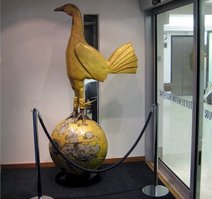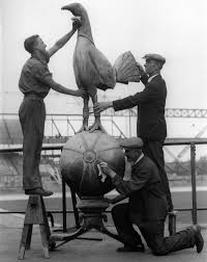 Judging by the responses that arrive by various means these trips down to the archive at Hotspur Towers have slowly built up an interested following. It is indeed a joy to know that so many fans want to learn about the rich tapestry that is the clubs history and that football existed before 1995 as the TV companies would like us to believe. I think we have a couple of more stories this season you will enjoy. As this is (amazingly) the 50th in the series I thought we should find something special and what could be more fitting than the cockerel. It has adorned the stadium for over a hundred years and has become known throughout the world as a symbol of the club.  The figure stood 9ft. 6in. tall. The ball being 31 inches in diameter and the bird itself five foot high. The span from its beak to the tail was 3ft. 6in. and overall was 15 inches thick. The copper masterpiece was fixed to the mock-Tudor gable of the new West Stand in November 1909. It remained there until the summer of 1934 when the West Stand roof was renewed. This was at the same time as the East Stand was being constructed. Left - The East Stand under construction in the background. The cockerel and ball has been associated with Tottenham Hotspur for over a hundred years. Much of that time it has been perched on top of the stands overseeing events below. The contact for the figure was awarded to a copper-smith who worked in the Euston Road in North London. F. Braby and Co. The figure which cost £35 was actually the work of one William James Scott. Scott who was born in Edmonton had actually played a handful of games for the club in the 1896/97 season.  An interesting note is that the 1934 season saw Spurs finish third in the table. That summer the bird was brought to earth. The year after in 1935 we finished bottom and were relegated. Many fans of that time felt that the removal of the cockerel even for a short period had brought bad luck on the club. While the cockerel was down to earth it was spring cleaned and a number of local dignitaries took the opportunity to examine the piece up close as well as having a photograph taken with the areas most famous local celebrity.  It was returned to the West Stand and remained in place under 1957. At this point additional floodlighting was installed. The original lights appearing in 1953. Extra lights were installed on the mock-Tudor gable and this required the bird to once again descend. There was a delay and the bird did not reappear again until the December 1958. This time on the East Stand on top of the press box in between two mounted banks of lights. A week after the last home game of the season (a home win V Everton) and possibly to help avoid further bad luck on 28th. April 1989 it was once again brought to earth. This time for its final rest. Refurbishment work was being undertaken on the East Stand roof.  At this point the club took the opportunity to open the ball and see what was inside. Many a rumour had grown during the years about what had been placed inside the structure. It was found that a handbook from the year of its erection 1909/10 had been placed there along with some coins. It had been decided that having withstood the weather for eighty years and two wars the bird should be kept in place of safety. For a while it was housed in the executive area in the East Stand. It now has pride of place in the reception area of the West Stand. The club erected two offspring. One stands on each stand. These are made of fiber-glass. The cockerel has been linked to Tottenham since its earliest days. The cockerel motif first appeared on the clubs shirt in 1921 (1). Phil Sour in his official history of the club states that “certainly by the turn of the (19th) century newspaper cartoons were featuring Tottenham as a cock and this continued until around 1950 when this kind of illustration began to die out.” Some of these examples of the Cocky Cockerel drawings depicting the club were previously discussed (2). It was also a regular on the cover of the clubs programmes prior to World War 2. (3).
Long may he continue to look over our fortunes and give us much to crow about. COYS Keith Harrison. t- Keith 16024542 f- peter shearman (old non de plume reserved for THFC matters) Thanks – Andy Porter, THFC, Bob Goodwin, Phil Sour, Summerfield Association, Weekly Herald. Notes – 1 – Hotspur Towers 41. 2 – Hotspur Towers - What the papers drew 3 - Hotspur towers 48
6 Comments
alok
6/5/2015 08:31:26 am
Cockerel and spurs are synonymous. I somehow find this was the only thing that could ever make our crest. I cannot imagine any other thing than the cockerel. Great article. Thank you
Reply
keith
7/5/2015 03:37:24 am
Hi Alok, always good to hear from you. glad you enjoyed it.
Reply
arsene wenger
6/5/2015 05:05:34 pm
Comment deleted
Reply
karthik
6/5/2015 05:06:14 pm
Why are gooners on our website?
Reply
Rich
6/6/2016 06:43:00 pm
I'd heard bits of the story before but never all put together like this. Great article, thanks
Reply
will
18/5/2018 03:33:46 pm
So after being completely safe against the ravages of time for all those tumultuous years "they" decided to take it down. And then be cheap and have badly made Fibreglass "replicas". This is a world renowned icon. So some respect. Spurs fans should be up in arms about this - the original should had been checked, cleaned and treated and restored to the building. And the replicas should be Bronze too. I hate this cheapening of identity.
Reply
Leave a Reply. |
Features
Flying Down to Rio History of T.H.F.C. Tribute to Bill Nicholson Talking Tottenham Early Legends The Road to Turin International Connections Hotspur Towers Most Read Articles
The 100 Year War Interview with Marina Sirtis A Long Dark Shadow By Royal Appointment School Report: An Insight into the Younger Eric Dier Dear Jimmy All Change At Spurs Hotspur Towers History Of THFC: Part 1 Passage to India: Rohan Rickets Thanks For The Memories Our Tommy Carroll The AVB Files: Part1 The Lilywhites You The Jury The Hand Of Hugo Connection - Argentina Creating a Reputation One Hotspur Archives
August 2018
Categories
All
|
 RSS Feed
RSS Feed

